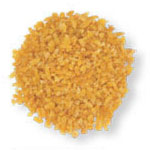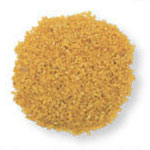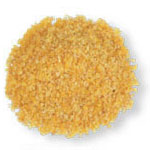Bulgur is a cereal food made from several
different wheat species, but most often from Durum Wheat. The
key attributes of traditional Bulgur production are that the
Durum Wheat grain is parboiled, dried, de-branned, milled, and
polished. Bulgur is often confused with Cracked Wheat, which is
made from crushed wheat grains which have not been parboiled.
Bulgur can be used in pilafs, soups, bakery goods, or as
stuffing, but is best known as a main ingredient in tabouli
salad and kibbeh. Also, its high nutritional values make it a
good substitute for Rice or Couscous. In Indian cuisine, Bulgur
or Daliya is also used as a cereal with milk and sugar.
Bulgur is 85 % Carbs, 13 % Proteins, and 2 % Fat which makes it
healthier than rice. Bulgur is very low in Saturated Fat,
Cholesterol, and Sodium. It is also a very good source of
Dietary Fiber and Manganese. Bulgur tastes great and is a very
good source of Carbohydrates in case you are counting the
Calories.

Coarse Bulgur

Medium Bulgur

Fine Bulgur




